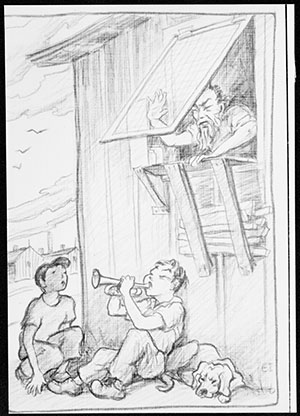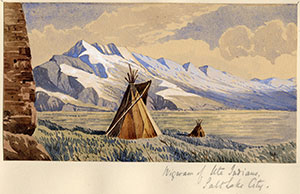
Western art often portrays the West with majestic mountains and rock formations; exotic native animals such as bison and pronghorns; extreme weather; or the colorful people whose lives have been shaped by the region.
The University of Wyoming American Heritage Center’s (AHC) new exhibition, “Artwork of the West: The American Frontier from Four Artists,” contrasts that approach with works in which artists portrayed everyday occurrences in their hometowns; they focused on their place in the West rather than the West itself. The art on display comes from the AHC’s own collections.
Born in Germany in 1887, Hans Kleiber came to the American West as a teenager. He labored as a logger and then went to work for President Teddy Roosevelt’s newly formed U.S. Forest Service in 1906. He and his family settled in Dayton, where he became a full-time professional artist in 1924. He became nationally known for his etchings of Western scenes. The exhibition features several scenes from Dayton and the Big Horn Mountains.
Carrie Arnold took her art and her love of Wyoming’s history and combined them into annual creations that she shared through Christmas cards for more than two decades. These scenes featured the small Wyoming towns of Hartville and Sunrise, providing historical glimpses of the residents as well as the towns themselves.

Estelle Ishigo’s Western town was the “relocation center” at Heart Mountain. Estelle was a Caucasian who married Arthur Ishigo, an American citizen of Japanese ancestry, after they met at school in Los Angeles. When the U.S. government decided during World War II to take people of Japanese descent from their homes and imprison them in camps in the country’s interior, Estelle accompanied her husband to Heart Mountain. She used her artistic talents to record life in that Western settlement, sometimes emphasizing the harsh conditions, other times recording a humorous incident.
In contrast to the three other artists, Thomas Kennet-Were was a wealthy English traveler who crossed the U.S. on the newly opened transcontinental railroad in 1869. To him, America was exotic and the West even more so. His paintings reflect that, emphasizing majestic or striking aspects of American landscape and cities.
The “Artwork of the West” exhibition will be open through the summer at the AHC. The hours are 10 a.m.-5 p.m. Monday through Friday.

